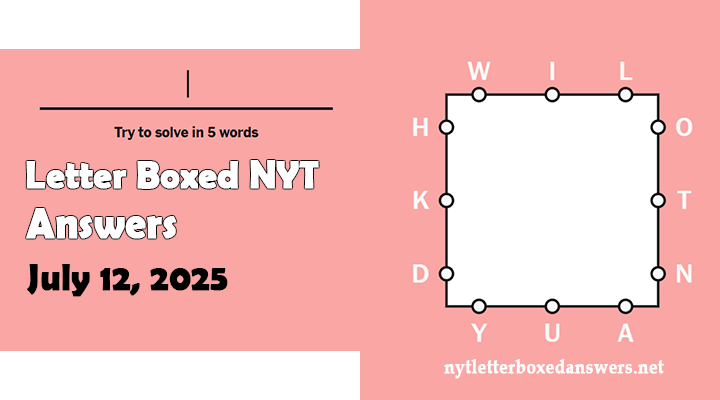NYT Letter Boxed quiz for Saturday July 12, 2025 is released. We came up with Letter Boxed July 12 2025 Answers and Hints for you. With the help of these hints, you will be able to guess the words of letter boxed quiz without revealing the answers and get the solution.
| Top | Right | Bottom | Left |
|---|---|---|---|
| WIL | OTN | YUA | HKD |
| Two Words Solution | ||
|---|---|---|
| WAHLUND | DAKOITY | |
| WALNUT | THYLAKOID | |
| WANKLY | YOUDITH | |
| WHODUNIT | THYLAKOID | |
| Three Words Solution | ||
|---|---|---|
| AKYL | LAW | WHODUNIT |
| AKYL | LOW | WHODUNIT |

Word 01:
This 7-letter word starts with W and ends with D; refers to the Wahlund effect, a reduction in heterozygosity in a population due to subpopulation structure.
Commonly used in population genetics and evolutionary biology.
Named after Swedish geneticist Sten Wahlund.
Often caused by non-random mating in structured populations.
Results in an excess of homozygotes over Hardy-Weinberg expectations.
Demonstrates how genetic variation can be masked.
Important when analyzing allele frequencies in fragmented groups.
Cited when testing for population stratification.
Reveals internal structure in genetically diverse groups.
A foundational concept in evolutionary studies.
Word 02:
This 7-letter word starts with D and ends with Y; refers to armed robbery by a gang, particularly in South Asia.
Common in Indian English legal and crime terminology.
Involves violence or intimidation by a group.
Typically conducted at night in rural regions.
Derived from Hindi dākū meaning bandit.
Legally distinct from burglary or petty theft.
Often prosecuted under anti-bandit laws.
Historically romanticized in some folklore.
Associated with dacoit gangs in Indian history.
Has equivalents like banditry or gang robbery.
Word 01:
This 6-letter word starts with W and ends with T; a type of tree or its edible, brain-shaped nut.
Used in baking, salads, and nut mixes.
Rich in omega-3 fatty acids and antioxidants.
Hard-shelled with a slightly bitter outer layer.
Also prized for dark, high-quality wood.
Found in both wild and cultivated varieties.
Used in furniture, cabinetry, and carving.
Native to North America, Asia, and Europe.
Common species include English and Black varieties.
Symbolic in some cultures for wisdom or intelligence.
Word 02:
This 9-letter word starts with T and ends with D; membrane-bound structure within chloroplasts, vital for photosynthesis.
Hosts the light-dependent reactions of photosynthesis.
Contains chlorophyll and other pigments.
Arranged in stacks called grana.
Connected by lamellae in plant cells.
Essential for ATP and NADPH production.
Surrounded by stroma in chloroplasts.
Resembles flattened discs under a microscope.
Appears in textbooks on plant biology.
Its name combines Greek roots for “sac” and “form.”
Word 01:
This 6-letter word starts with W and ends with Y; a rare or dialect term possibly meaning weakly, feebly, or lacking confidence.
May appear in informal or regional English.
Sounds like a blend of “wobbly” and “weakly.”
Could describe unstable or awkward motion.
Sometimes used metaphorically for uncertain effort.
Rare in contemporary dictionaries.
Could be mistaken for slang or typo.
May carry humorous or derogatory tone.
Uncommon enough to puzzle readers.
A possible nonce word or dialectal variant.
Word 02:
This 7-letter word starts with Y and ends with H; likely a variant or fictional spelling of “Judith.”
Could be a proper noun, name, or cultural reference.
Appears in historical fiction or fantasy.
May be a creative or poetic reinterpretation.
Possibly used as a pseudonym or character name.
Rare in official name registries or literature.
May suggest heritage or stylized identity.
Can be used for uniqueness in naming.
Shares phonetic base with a biblical figure.
Most likely a constructed or stylized personal name.
Word 01:
This 8-letter word starts with W and ends with T; a mystery story centered around discovering the perpetrator.
Classic genre in detective fiction.
Popularized by Agatha Christie and Arthur Conan Doyle.
Short for “Who has done it?”
Often includes red herrings and plot twists.
Encourages reader to solve the puzzle.
Features a detective or amateur sleuth.
Settings include mansions, trains, or small towns.
Common in both novels and TV dramas.
Known for suspense and clever misdirection.
Word 02:
This 9-letter word starts with T and ends with D; membrane-bound structure within chloroplasts, vital for photosynthesis.
Hosts the light-dependent reactions of photosynthesis.
Contains chlorophyll and other pigments.
Arranged in stacks called grana.
Connected by lamellae in plant cells.
Essential for ATP and NADPH production.
Surrounded by stroma in chloroplasts.
Resembles flattened discs under a microscope.
Appears in textbooks on plant biology.
Its name combines Greek roots for “sac” and “form.”
Word 01:
This 4-letter word starts with A and ends with L; possibly a variant of “alkyl,” a chemical group derived from alkanes.
Appears in organic chemistry contexts.
In real-world use, may be a misspelling.
Could also be a unique name or fictional term.
Might appear in stylized texts or tech branding.
Resembles terms in molecular naming conventions.
Suggests non-standard lexical use.
Potential candidate for fictional characters.
Sounds scientific, though undefined.
Lacks established dictionary definition.
Word 02:
This 3-letter word starts with L and ends with W; system of rules enforced by social institutions.
Includes civil, criminal, and constitutional branches.
Used to maintain order and deliver justice.
Interpreted by judges and enacted by legislators.
Applies locally, nationally, and internationally.
Also used to describe natural principles, like gravity.
Found in legal codes, statutes, and treaties.
Studied in fields like jurisprudence and philosophy.
Essential to society’s structure and governance.
Can evolve through precedent or reform.
Word 03:
This 8-letter word starts with W and ends with T; a mystery story centered around discovering the perpetrator.
Classic genre in detective fiction.
Popularized by Agatha Christie and Arthur Conan Doyle.
Short for “Who has done it?”
Often includes red herrings and plot twists.
Encourages reader to solve the puzzle.
Features a detective or amateur sleuth.
Settings include mansions, trains, or small towns.
Common in both novels and TV dramas.
Known for suspense and clever misdirection.
Word 01:
This 4-letter word starts with A and ends with L; possibly a variant of “alkyl,” a chemical group derived from alkanes.
Appears in organic chemistry contexts.
In real-world use, may be a misspelling.
Could also be a unique name or fictional term.
Might appear in stylized texts or tech branding.
Resembles terms in molecular naming conventions.
Suggests non-standard lexical use.
Potential candidate for fictional characters.
Sounds scientific, though undefined.
Lacks established dictionary definition.
Word 02:
This 3-letter word starts with L and ends with W; describes something small in height, value, or intensity.
Can refer to sound volume, mood, or quantity.
Used in pricing, emotion, and measurement.
Also refers to cattle sounds in a separate sense.
Antonym of “high.”
Appears in weather forecasts and stock markets.
Frequently used in idioms like “feel low.”
Related to decline or drop.
Simple yet versatile in English usage.
Found in comparisons and rankings.
Word 03:
This 8-letter word starts with W and ends with T; a mystery story centered around discovering the perpetrator.
Classic genre in detective fiction.
Popularized by Agatha Christie and Arthur Conan Doyle.
Short for “Who has done it?”
Often includes red herrings and plot twists.
Encourages reader to solve the puzzle.
Features a detective or amateur sleuth.
Settings include mansions, trains, or small towns.
Common in both novels and TV dramas.
Known for suspense and clever misdirection.

Chris Brown is a passionate word game love and problem solving expert. With over 15 years of experience in solving puzzle challenges, he provides daily NYT Letter Boxed answers, tips and strategies to help other players so that they can improve their solving skills. Whether you are stuck on a tricky puzzle or looking for new techniques, Chris is here to guide you with his expert solutions.